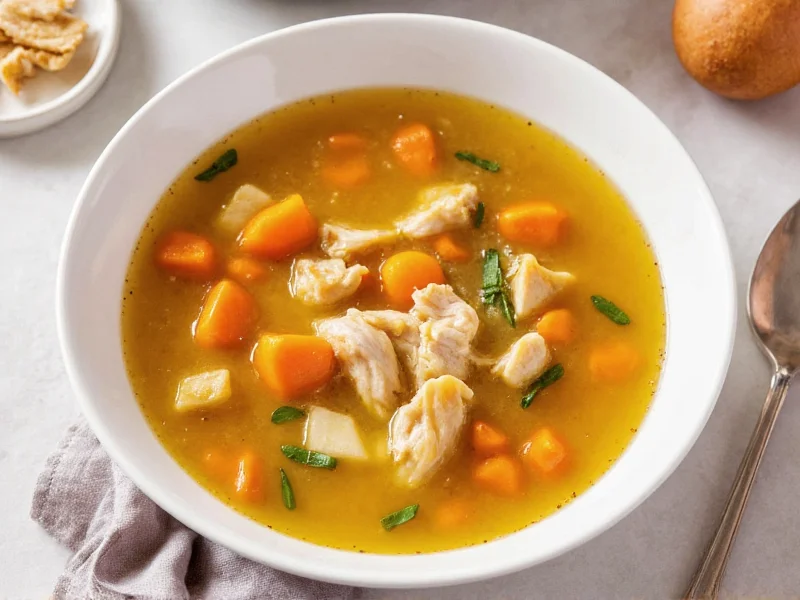For centuries, cultures worldwide have turned to chicken soup when fighting colds. But beyond comforting tradition, modern science reveals specific physiological reasons why this humble remedy works. Research published in Chest journal demonstrates that chicken soup inhibits neutrophil migration, reducing inflammation in the upper respiratory tract. The steam from hot soup acts as a natural decongestant, while the broth replenishes fluids lost through fever and mucus production.
The Science Behind Soup's Cold-Fighting Properties
Chicken soup's effectiveness stems from its unique combination of ingredients working synergistically. The broth provides electrolytes and hydration crucial when fighting infection. Steam from hot soup loosens mucus and soothes irritated nasal passages. Vegetables like carrots, celery, and onions contain antioxidants and vitamins that support immune function. Chicken provides protein essential for tissue repair and antibody production.
Key Research Findings on Chicken Soup and Colds
A landmark 2000 study from the University of Nebraska Medical Center tested 13 commercial and homemade chicken soups for their effect on neutrophil chemotaxis (white blood cell movement). The researchers found that chicken soup significantly inhibited this inflammatory response, potentially explaining its symptom-relieving effects. While not a cure, chicken soup appears to modulate the body's inflammatory response to upper respiratory infections.
| Mechanism | Scientific Explanation | Observed Benefit |
|---|---|---|
| Anti-inflammatory effect | Inhibits neutrophil migration to infection sites | Reduces nasal congestion and throat irritation |
| Hydration | Provides fluids with electrolytes | Prevents dehydration from fever and mucus production |
| Steam inhalation | Warm vapor loosens mucus | Improves breathing and reduces sinus pressure |
| Nutritional support | Protein, vitamins, minerals from ingredients | Supports immune function during illness |
Historical Context of Chicken Soup as Medicine
The use of chicken soup for respiratory ailments dates back to the 12th century, when Jewish physician Moses Maimonides recommended it for respiratory conditions. In many cultures, chicken soup earned the nickname "Jewish penicillin" for its perceived healing properties. While traditional wisdom preceded scientific validation, modern research increasingly supports these age-old practices, though with important caveats about what soup can and cannot do.
What Chicken Soup Can and Cannot Do
It's crucial to understand that chicken soup doesn't cure colds or shorten their duration. Viruses cause colds, and no food can eliminate them. However, chicken soup effectively manages symptoms through several mechanisms:
- Provides hydration when swallowing may be difficult
- Delivers warmth that soothes sore throats
- Offers easily digestible nutrition when appetite is low
- Creates steam that clears nasal passages
- Contains compounds that may reduce inflammation
Chicken soup works best as part of comprehensive cold care that includes rest, hydration, and appropriate over-the-counter medications when needed. It's not a substitute for medical treatment when symptoms are severe or persistent.
Creating Therapeutic Chicken Soup
Not all chicken soups offer equal benefits. Research suggests homemade versions with specific ingredients provide the most therapeutic value. Key components include:
- Chicken bones - Release collagen and gelatin when simmered, which may support gut health and immunity
- Garlic and onions - Contain allicin and quercetin with potential antimicrobial properties
- Carrots and celery - Provide vitamins A and K that support immune function
- Herbs like thyme and parsley - Contain antioxidants and may have mild antimicrobial effects
For maximum benefit, simmer bones for 12-24 hours to extract nutrients, then add vegetables and chicken meat for the final cooking phase. Avoid excessive salt, which can dehydrate. The optimal temperature for consumption is warm but not scalding - hot enough to produce steam but cool enough to drink comfortably.
When to Seek Medical Attention
While chicken soup provides symptomatic relief, certain cold symptoms warrant medical evaluation. Consult a healthcare provider if you experience:
- Fever above 103°F (39.4°C) lasting more than three days
- Difficulty breathing or shortness of breath
- Symptoms lasting longer than 10-14 days
- Severe headache or facial pain suggesting sinus infection
- Dehydration symptoms like dizziness or reduced urination
Chicken soup complements but doesn't replace appropriate medical care for serious conditions. It's most effective for mild to moderate cold symptoms as part of supportive care.
Practical Tips for Maximum Benefit
To get the most from chicken soup when fighting a cold:
- Consume soup while hot to maximize steam inhalation benefits
- Sip slowly throughout the day rather than drinking large quantities at once
- Add a squeeze of lemon for vitamin C and flavor
- Include garlic in your recipe for potential antimicrobial effects
- Pair with rest and adequate sleep for optimal recovery
Research shows that the psychological comfort of familiar foods during illness also contributes to perceived symptom relief. The ritual of preparing and consuming chicken soup may provide additional therapeutic value beyond its physical properties.











 浙公网安备
33010002000092号
浙公网安备
33010002000092号 浙B2-20120091-4
浙B2-20120091-4